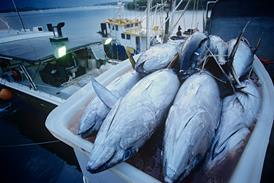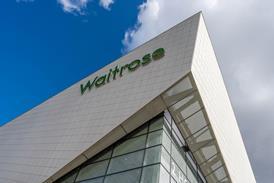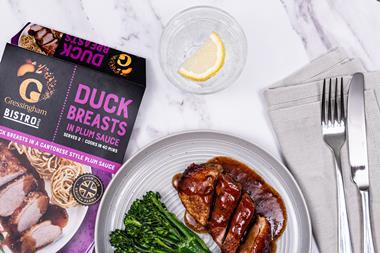All systems low
Asda claims it can build three stores for the price of two, aims to beat the industry on price and push non-food hard, says Helen Gregory
The Asda board is upbeat about the chain's future and blunt about its failings.Its youthful directors are bursting with enthusiasm and all keen to get across its strategy for future growth to be cheaper than the cheapest while ditching promotions and becoming much bigger in non-food, using the most advanced Wal-Mart systems.
CEO Paul Mason says he rates 1,200 Asda grocery prices each week against the industry and believes the chain is already well ahead of the pack. Last week it was 35% cheaper than Safeway. "We want to try to increase the gap between us and the rest of the industry this year," he says. "Tesco is playing the game too and that's great because it will spur us on."
A buoyant Mason says that apart from low prices, part of the chain's formula for growth is the simple "easy five": being able to park your car; find a trolley; get round the store easily; find products easily; and get through the checkout without problems. He says this, along with staff character and having good availability at all times, creates Asda's distinct personality and its recipe for success.
Mason acknowledges that Asda needs to keep refreshing its estate and replicate the offer across the portfolio, while looking at individual needs "What might be right in one place might not be right in another". And while updating stores, he also claims to be shaking up head office and management, restructuring every part of the business in the last six months in a bid to make sure it is leveraging gains from being part of Wal-Mart (there are now only 17 expat Americans based at Asda House).
The trading department now with one less layer of management is more responsive, Mason asserts: "We don't want to be hamstrung by the past which can drag us down by inertia. We'll continually look to improve our processes."
Asda will have 250 stores in the UK by the end of the year and boasts that it can now build three stores for the price of two.
Floor space is a big issue for the chain and it is keen to utilise every centimetre. Mason says it has a large ancillary space which it can give over to non-food speciality areas and as proof of this, Asda will have 20 jewellry offers in its stores by the end of the year, along with 50 photo shops, 50 opticians and 100 pharmacies.
More space generally will be devoted to non-food but director of store development, Angela Spindler, promises that it will not mean less range a current 75:25, food/non-food ratio could drop to 55:45 just that food space will be better managed. "We aim to improve sales per square foot, develop new formats and introduce new ranges," she says.
The initiative Renewal III will reduce food hall space by 15% and increase non-food space by 5,000sq ft in 12 stores. Alongside this, a new 25,000 sq ft small-style store opening in Bodmin, Cornwall, at the end of April, will have 17,000 sq ft of food the smallest food space proportionately in an Asda store. Both ideas will be rolled out if they prove successful. The chain aims to maximise profitable selling space generally. "There'll be as much change in the next two years as there was in the last 10," adds Spindler. "We innovate or we die."
Asda admits that many of its customers don't know about, appreciate or buy its non-food range. Something general merchandise director Tony Page says has to be addressed.
One in seven Asda shoppers buy Home & Leisure products and one in four buy Health & Beauty. He calls it a "huge opportunity" and adds that the challenge is to get a superstore range of non-food into as many stores as it can.
Page admits that Asda's systems were six months behind Wal-Mart when the two merged, but that general merchandise buying is now aligned with the parent company and that he aims to bring Wal-Mart brands to Asda stores.
"Consumers told us last year that our general merchandising wasn't cheap enough and we didn't do it properly.
"We need to be cheaper than the cheapest. We need to have a campaign featuring low prices. At the moment many of our customers think Superdrug is cheaper than us. We need to address this."
Page says that already, prices are much lower than last year PC games are 40% cheaper and bath and bedding goods are 29% cheaper both helped by much lower entry price points.
He says that despite the deflationary impact, Asda is picking up the volume. "We're getting lower costs by sourcing globally, which allows us to cut prices.
"We're totally aligned with Wal-Mart's buying processes now. We can piggy-back their negotiations."
Asda now aims to refine its general merchandising offer in supercentres before rolling it out into smaller stores. Clothing will be a big focus, initially by dropping price entry points.
Its clothing strategy is to source from the lowest cost supply without compromising on quality or its ethical stance and to establish George as a centre for excellence for design and buying within Wal-Mart.
George managing director Andy Bond is upbeat about the brand's future, but admits he needs to get even more shoppers into the George department.
Already, huge price cuts are pulling in shoppers kids' t-shirts reduced from £3.50 to £2.50 now sell at 10 times the volume and men's jeans reduced from £16.99 to £9 have gone from selling 2,000 a week to 60,000.
"The average price has come down 11% year on year and we have driven volume by investing in margin. We're making a hell of a lot more money," says Bond.
Price will also be a key driver in food, although the in-store marketing mechanics will alter slightly.
Food business unit director Dave Cheesewright admits that the message is not always getting across. "I don't think shoppers quite get how good our price position is yet. We need to talk about Asda Price more in store and use the promotional material Bursting with Low Prices' as a message to be much more price focused. The Rollback literature had become like wallpaper to customers for us it's now less is more'."
He says Asda aims to take promotions which can confuse price clarity out of the business and make customers not consider shopping anywhere else.
"Promotions discriminate against customers such as those who don't always need three products for the price of two they use people's homes as warehouses.
"EDLP is right for us and we can play the game longer than anyone else."
Smart Price is the most important part of Asda's EDLP initiative and the brand is proving popular with shoppers. "In week nine, sales of Smart Price food were 46% ahead of last year," says Cheesewright.
The Great Value brand is also doing well, despite Asda's concerns when it was introduced. The chain feared it would lose about 20% of volume in frozen food when it removed promotions last summer. It cut prices on 750 lines and repackaged products with the Great Value brand and as a result, from July to December, frozen was the fastest growing category, with 10% more volume, 5% more sales and 7% more profit. He adds: "We're better now at looking at categories and deciding where to invest."
But Cheesewright adds that customers are less forgiving of stores with an EDLP focus: "You need to have much better service."
{{FEATURES }}
Close menu
- Home
- Retail & Wholesale
-
Products & Suppliers
- Back to parent navigation item
- Products & Suppliers
-
Product Categories:
- Back to parent navigation item
- Product Categories:
- Alcoholic drinks
- Bakery
- Cereals & breakfast
- Cheese
- Chicken & poultry
- Chocolate
- Confectionery
- Crisps, nuts & snacks
- Dairy
- Fish
- Fresh produce
- Frozen
- Household
- Meat
- Own Label
- Sauces & condiments
- Seasonal
- Soft drinks
- Vaping
- Vegan & plant-based
- World foods
- Suppliers
- People
- Reports & Data
-
Topics A-Z
- Back to parent navigation item
- Topics A-Z
-
Popular topics:
- Back to parent navigation item
- Popular topics:
- Cost of living crisis
- Crime
- Deposit Return Schemes
- Finance
- Government & Regulation
- Health
- Inflation
- Loyalty
- Marketing
- Mergers & Acquisitions
- New Product Development
- Sourcing
- Supply chain
- Sustainability & environment
- Technology
- Ultra Processed Foods
- Vaping
- A-Z all topics
- Content by type:
- Events
- Ask iA (beta)
- Subscribe now
Sign in to comment on this article
Not logged in before? Register for FREE guest access today.
You will be able to:
- Read more stories
- Receive daily newsletters
- Comment on stories
Advert



















No comments yet